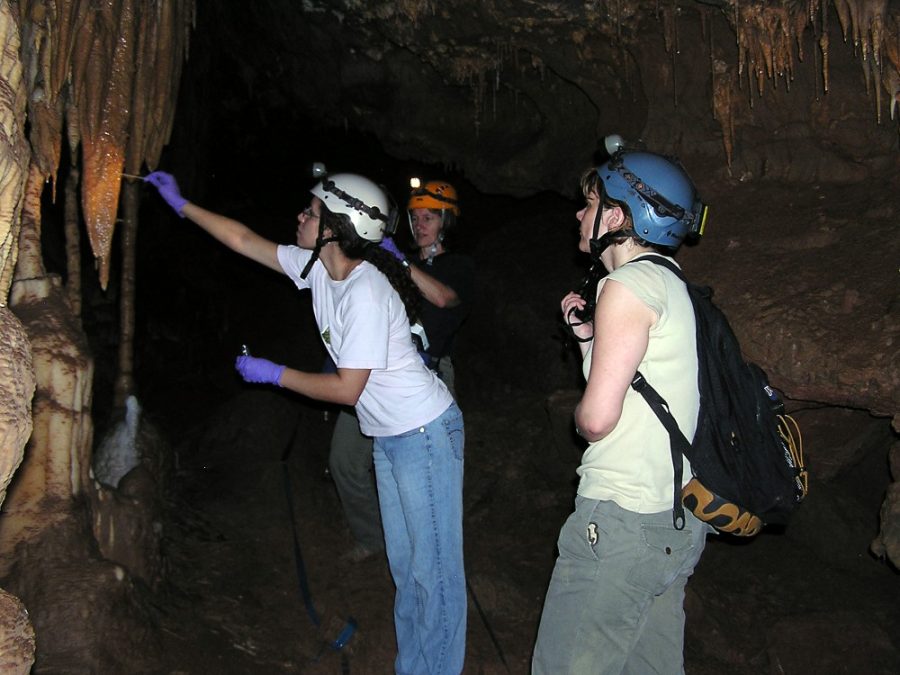When a tour passes through Kartchner Caverns, the park rangers say that the caverns are living, referring to the fact that the caves are still growing and changing — but a recent UA study found that life is in incredible abundance in the seemingly uninhabitable environment.
Published in the ISME Journal in mid-September, the study describes the diversity of bacteria, fungi and archaea, which Julia Neilson, a researcher in the Department of Soil, Water and Environmental Sciences, said she did not count on finding in the caves.
Neilson started studying the microorganisms of Kartchner Caverns in 2002, when sludge began to form on a false painted fiberglass rock within the Rotunda Room of the caverns.
“They would wipe it all down once a month with bleach, but after a month it would all come back,” Neilson said, “and it would be goopy, and they got really worried, because could this stuff take over the cave?”
After careful research, a group of researchers including Neilson and Raina M. Maier, a professor in the Department of Soil, Water and Environmental Sciences, looked into the issue.
“On the surface of the Earth, you have photosynthesis. You have plants that fix carbon dioxide into glucose … but fixing carbon takes a lot of energy,” Neilson said.
Because the caves are pitch black, their main source for carbon is drip water trailing down through faults. However, in Kartchner Caverns, the drip water contains 1000 times less fixed carbon than one would expect to find in a cave in Kentucky or Virginia.
The bacteria were fixing the carbon from the paint, research found, and it gave them enough energy to then produce the slime.
This brought up a new question: What life can be found in Kartchner Caverns? A research group was formed to investigate, consisting of five principal investigators, several graduate students and a $1.6 million grant from the National Science Foundation.
From 2006 to 2012, the team took several thousand samples. But according to Barry Pryor, an associate professor in Plant Pathology and Microbiology and co-principal investigator for the project, there are several barriers to performing research on microorganisms.
“About 80 percent of the things we find in the environment, we cannot grow in the lab,” Pryor said. “We just cannot do it.”
One way to work around these barriers is to sample DNA. Hundreds of cotton swabs are dipped in sterile water and swiped on different structures in the cave. The samples are then multiplied so that there is enough to test. A process called gel electrophoresis is used to sequence the DNA, allowing scientists to see the exact genetic code for the sample.
Once this massive amount of information was organized and deciphered, the team discovered that the life inside the cave is widely varied. Even when a single stalactite was sampled in different regions, the types of bacteria were different, but when two adjacent stalactites were sampled, the difference was immense.
Neilson’s work also found that bacteria are partially responsible for the formation of calcite structures in the cave, which brings up an interesting series of questions: “What happens when we disturb these bacterial communities?” Pryor asked. “Will we contaminate them with our own bacteria? … Can simply our presence in the cave negatively impact calcite formation?”
The data suggests that the answer is yes, and Pryor worked for several months with Biomedical Communications at the Arizona Health Sciences Center to create media for a kiosk to educate people on what they could be disturbing and how their conduct affects the cave.
According to Neilson, there is still a lot more research to be done in Kartchner Caverns.
“We still have tons of data that we can mine,” Neilson said. “We have millions and millions of sequences, and we’ve asked a few questions: What’s the carbon source for the cave? What’s the energy source for the cave?”
With a wealth of potential answers in front of them, the researchers are looking to ask the right questions.









